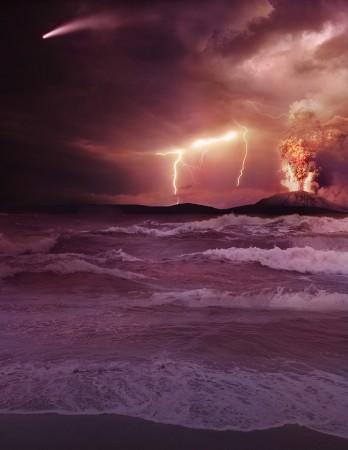Two billion-year-old salt left over from ancient seawater in the early days of the planet's evolution explains how the atmosphere became oxygen rich and able to sustain life that eventually led the planet into becoming what it is right now.
The Great Oxidation Event, a biological process, transformed the atmosphere into an oxygen rich one, but recent study suggests that it was a lot more widespread and quicker than previously believed.
"Instead of a trickle, it was more like a firehose," said Clara Blättler, from the Department of Geosciences at Princeton University and first author on the study. "It was a major change in the production of oxygen," she added.
Evidence of this "major change" of oxygen release into the atmosphere, as the researchers described it, came from crystallized salt rocks extracted from a two kilometer deep shaft that was drilled in Karelia in northwest Russia. The salt was part of an ancient sea that evaporated and left behind salt that was then buried deep underground.
The samples are about 2.3 billion years old and offer geologists an unprecedented view of the chemical makeup of the ancient world. A key finding from the mineral deposit and evidence of oxygen production is the presence of a large amount of sulphate. It is a component of sea water which is formed when oxygen reacts with sulfur, notes the report.
"This is the strongest ever evidence that the ancient seawater from which those minerals precipitated had high sulfate concentrations reaching at least 30 percent of present-day oceanic sulfate as our estimations indicate," said Aivo Lepland, a researcher at the Geological Survey of Norway and senior author on the study.
"This is much higher than previously thought and will require considerable rethinking of the magnitude of oxygenation of Earth's 2-billion year old atmosphere-ocean system," he explained.
The Great Oxidation Event, notes the report, happened when cyanobacteria that were capable of photosynthesis – using sunlight and carbon dioxide to release oxygen – started pumping oxygen into the air.
The question that remained unanswered until the recent study came along was whether this process was gradual, with the bacteria taking millions of years to add the 20% oxygen level in atmosphere, or if it happened quickly.
"It has been hard to test these ideas because we didn't have evidence from that era to tell us about the composition of the atmosphere," Blättler said.
The Russian salt deposits collected happens to be the oldest salt ever found. It is at least a billion years older than the oldest salt found before it, according to the report. This sample contains halite or rock salt and is identical to table salt and it has sodium chloride, and traces of calcium, magnesium, and potassium.
"This is a pretty special class of geologic deposits," said John Higgins, assistant professor of geosciences at Princeton, who provided interpretation of the geochemical analysis along with other co-authors.
"There has been a lot of debate as to whether the Great Oxidation Event, which is tied to increase and decrease in various chemical signals, represents a big change in oxygen production, or just a threshold that was crossed.
"The bottom line is that this paper provides evidence that the oxygenation of the Earth across this time period involved a lot of oxygen production."






!['Had denied Housefull franchise as they wanted me to wear a bikini': Tia Bajpai on turning down bold scripts [Exclusive]](https://data1.ibtimes.co.in/en/full/806605/had-denied-housefull-franchise-they-wanted-me-wear-bikini-tia-bajpai-turning-down-bold.png?w=220&h=138)



